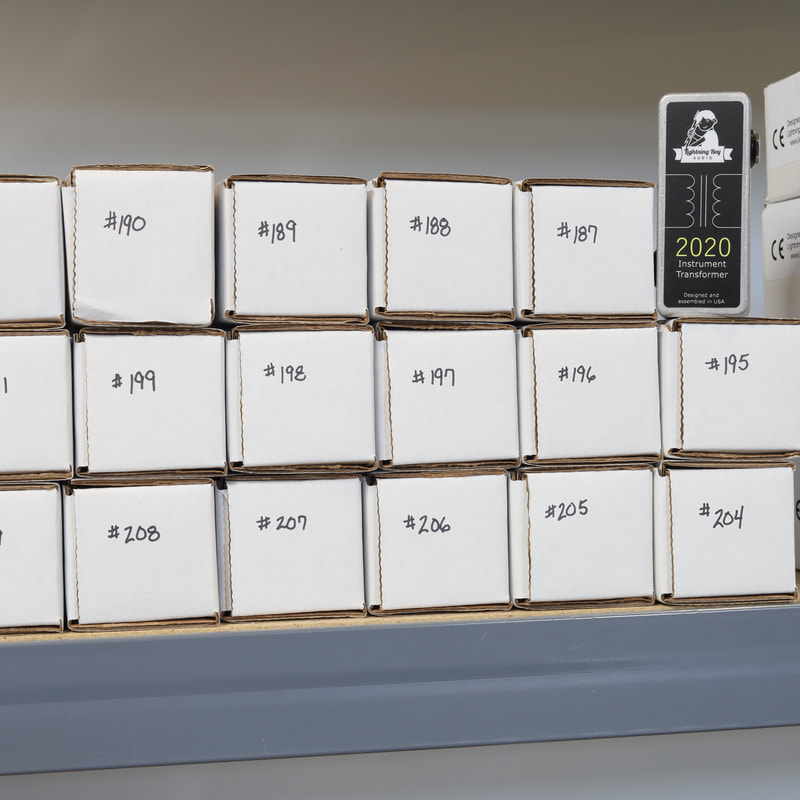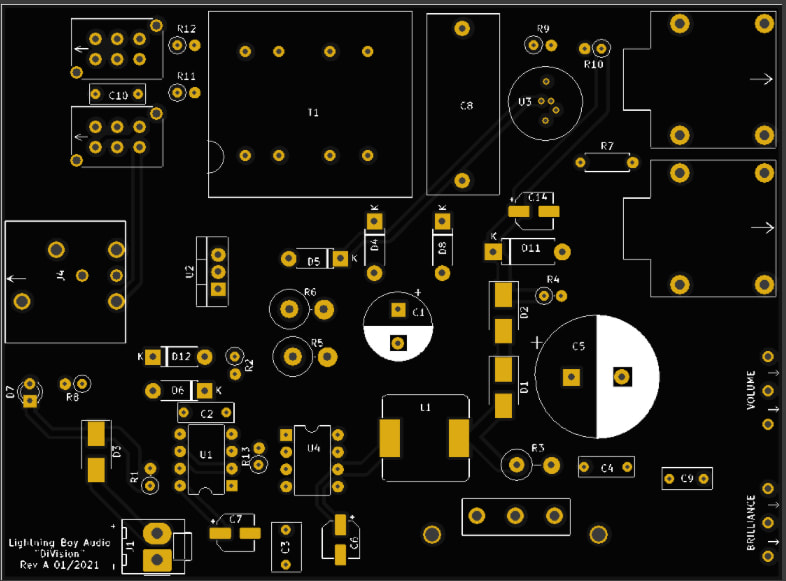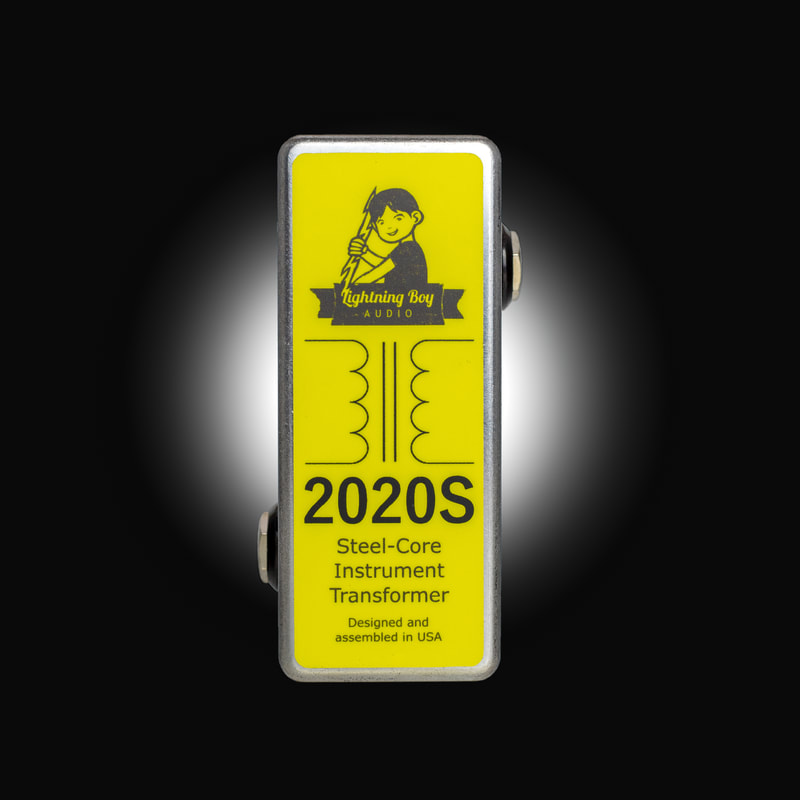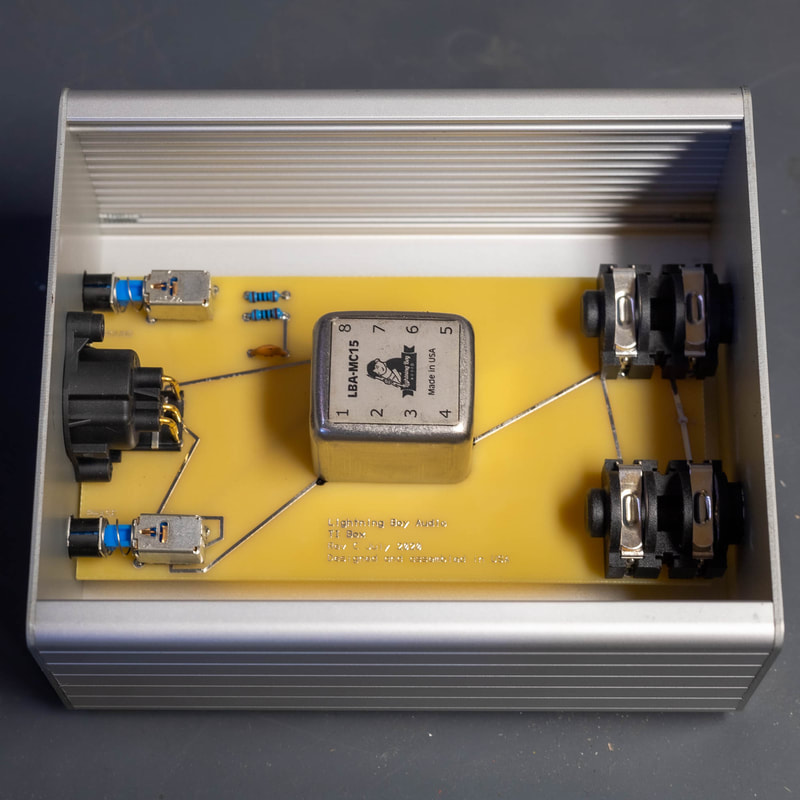|
DiVision - nuvistor vacuum tube powered direct box with an LBA-MC15 transformer. There's 14 people on the wait list for the pre-release. They will get first dibs. Only 68 DiVision's will be made - each one signed and numbered. I think I'll have the pre-release ready by next month. One diversion from the design criteria is the enclosure size. I wanted the DiVision to fit inside the same size die-cast enclosure as the NuVision pedal (Hammond 1590BB). However, after completely designing the DiVision electronics I realized it simply won't fit because there's a lot more electronics inside the DiVision. Here's a screen shot of the circuit board: How big is it? Well, its going to be mounted inside the same enclosure as the TI Box... and it just fits. There's enough vertical room inside the enclosure to allow for some heat dissipation. However, there is not much heat produced by this device. I spent a fair bit of time dialing in its performance to yield the highest possible efficiency. The exact performance was documented in a previous blog post if my memory serves correct. I had wanted to make it so you could power the DiVision from either 9V or 12V DC, but in testing I realized there were no benefits from 12V in this design and actually it made the DiVision run hot. So, stick with 9V DC power. It steps that voltage up internally to around 250V DC for the nuvistor to operate properly.
More to come as the pre-release closes in. I'm expecting this product to sell for $299 USD. Since it hasn't been officially released yet, I decided to make a couple changes to the design. These changes are based on my own experiences and feedback from a customer named, Jason. He's the only one so far to report any sort of noise. I even sent another one to him and he said it too had the same noise, which he didn't experience with the original version. I can't replicate that noise, so to be safe I'll be encapsulating the transformers in mumetal shielding cans, as is done with the original 2020. This will unfortunately raise the price a little. Also, we both noticed when running the 2020S after a NuVision pedal there is a huge low frequency cut. I don't know if this will happen with any other pedal and have not noticed it, but I have to assume it probably will with some. The original version did not have this issue. Its basically an impedance thing. A larger core would work, but it wouldn't fit in the enclosure and a larger shielding can would add a lot to the price - defeating the purpose of this design. My solution is to add 17.3% nickel to what was a 100% steel core. Doing this eliminated the bass cut issue. For reference, the original 2020 has an 80% nickel core.
These two alterations, a small percentage of nickel and a shielding can, will be the official release and it will bump it up to $95. If you like your preorder and aren't experiencing any noise issues, you'll have a bit of a rare object if you decide to not send it in for the update. If you would like it updated, you pay shipping to me, I'll update it for free and I'll pay to ship the finished product back to you. You should know the core modification does reduce the overall sonic coloration of the 2020S by some degree, but it is still more colorful sounding than than the original. It also improves the overall low frequency response of the 2020S. To my ears the sound/color of the updated version is smack dab between the original 2020 and the pre-release. To arrange for an update email [email protected] If I had all the money in the world I probably would live on a private tropical island, but I don't so I might as well have as much fun as I can with my limited funds in the snowy North. There are two things highest on my priority list at the moment. Releasing the 2020S is the primary goal for the immediate future, but that is pivoting around the secondary goal of buying a specialized high-end 3D printer. Its currently at a point of not wanting to do one without the other, so I'm trying to figure out how to best proceed. I'm paying obscene prices for the transformer bobbins to be manufactured from a company who is 3D printing them for me with a 3D file I provided. Furthermore, it takes 3-4 weeks for my orders to arrive, so its difficult gearing up for a product release based on these two factors. If I drop several thousand on a specialized machine I can make the bobbins in house whenever I want them and at a price 80% lower. Based on my sales from last year, the machine should pay for itself in under a year. That machine is a high priority, but buying it now will put me in a tight financial position. Contemplating my next move on that one.
The tube DI Box. There are 14 people on my list who requested direct notification of its availability. That exceeds the 10 required for me to move forward with the design. I worked on it more yesterday and made some final adjustments to the design. I have a parts list for this project that needs to be ordered, which totals several hundred dollars. The next step is probably the most difficult and that is to arrange the circuit to fit on a PCB that meets the dimensional constraints of the design. The prototype is a mess of mini prototype boards and a breadboard connected together with jumpers. Its powered by a benchtop power supply. There are multiple pieces of test gear spliced in circuit to analyze performance attributes. I have a bass plugged into the input and the output is connected to a Zoom H4N for recording samples so I can document the sonic effects of each circuit alteration made. Its a big pile of stuff on the bench. It doesn't look like it would fit inside of a pedal enclosure at this point, but I really won't know until I try. The design currently works best with a 9V DC input. At 9V it draws about 353mA. Internally it steps the voltage up to 200V for the B+. I have the tube biased the best I possibly can, balancing tube life with good tone. There will be two control knobs on the final product. One is for "brilliance," which is a high frequency shelving boost of 8dB starting at 10kHz. The other knob is an input volume attenuator. Having an input control makes way more sense to me than an output volume. You can attenuate the output with the mic preamp you'll be plugging the DI into. The input attenuator allows you to attenuate hot signals before hitting the tube's input if so desired. I so desired when putting a 2020S in front of the DI. It was such a cool sound to drive the 2020S hard and control its output with the "DiVision." Its a sound that instantly reminded me of early 1960's recording gear. The sound is a little hairy in a light, crisp way. Its not overly colorful, but certainly has a tasteful amount of "vintage" tone. That retro quality comes almost entirely from the 2020S, but combined with the 3D soundstage (big tube headroom) of the DiVision - that's what takes me to the early 60's. Anyway, I'm not sure how much more time it will take to turn this into a product. Its 3rd on the list of priorities, so maybe in February or March it will become a reality. Trinity. Will this finally be the year? It sure looks like it from where I'm standing. Based on the current prototype, the thousands of dollars needed to get it to the finish line, and the amount of work needed to develop the retail packaging, marketing strategies, advertising campaigns, etc, I'm expecting the earliest would be sometime late in 2021. Hopefully, in time for Winter NAMM, but that might be wishful thinking. Meanwhile, my friends over at http://kingbuffalo.com/ are recording a new record and they're doing it almost exclusively with Trinity channel strips (prototypes). I, for one, am very excited to hear the results. I have been in regular contact with Sean throughout the tracking of this record. He's been giving me updates along the way on how he is using the channel strips and the settings for each application. Its fascinating. I'm going to ask him if I can publish that information in a blog post. I think it'll be an awesome read. Stay tuned!
I figured the likelihood of it working was about 30%, but it was worth the try because the R&D cost would be low. The only way it could work is if the transformer had a lot more turns of wire than the 2020, so I procured the absolute finest wire I could find in order to fit it on the same bobbin. The first prototype surprisingly worked well, but I decided to wind another with some variations. After comparing the two to each other and the original 2020, I decided the second attempt was the better choice because it was the most colorful option. The first attempt sounded much closer to the original 2020, but I realize people want the maximum color possible - while still sounding good.
After the holiday break (today-January 2nd) I will return to start work on the demo video. I'll be comparing the 2020S to the original version and demonstrating how it saturates at a much lower volume than the original. I might even include a chain of multiple 2020S's. I have a bunch of these already made and boxed up. They will be the pre-orders. I'm accepting pre-orders until they run out. This is limited to 33 units. The official release date has not been determined yet, but should be expected for late January. Pre-orders can be placed here. Despite the pandemic, so far this year LBA has seen a growth in sales of 25% over its best year, which was 2018. I'm beyond words with my great appreciation for the people like you who have helped to support my electrical endeavors during these difficult times. The 2020 Instrument Transformer has sold 170 units since its release earlier this year (as of this post). Compared to the big companies that's a drop in the bucket, but for a one-man hand-made operation, I think its not too shabby. Thank you!
I have a fair quantity of products built and ready to ship. Because of this I've been spending my time over the past month working on 2 things. Number 2 is something the average bassist will appreciate and that's below. Number 1 is my beloved Trinity channel strip design. I'm working harder than ever on this and making great headway in all avenues (and there's a lot of avenues). The channel strip design has been complete in the sense of a working model that I'm 100% pleased with the performance of, as of October. The primary goal right now is to make it easy to build. I'll quote myself, "So easy a Grandma could put it together." The internals will be modular so if anything goes bad a module can be swapped out instead of having to send the whole channel strip in for repair. I haven't seen a failure from one yet. My oldest (in my possession) prototype is still performing like new after serving my studio for about 2 years. The earliest prototypes go back to over 5 years ago, many of which were sold and some decommissioned. Of those sold I haven't heard of any failures or issues, though I'm aware of some bugs with the early ones. At this point the design is becoming very mature and nearly ready for market. I hope to be able to offer the Trinity as a complete system sometime by the end of 2021. There are a couple other complimentary products that will be offered at the same time. 2. The past two day's I've been working on a vacuum tube powered DI Box which will be the size of one of my old pedals (Hammond 1590BB enclosure). Further design requirements are that it runs on 9V DC and draws less than 350mA. Well, as of today I have a working model that sounds quite special in my own opinion. It runs a single Nuvistor vacuum tube into an LBA-MC15 transformer. That's the same transformer as the TI Box. The system takes a 9V DC input at 320mA and converts it to 231V DC for the B+ to power the tube and drops it down to 5.8V for the heater filament of the tube. The filament is designed to operate at 6.3V, but with a NOS tube it will operate properly with a supply voltage as low as 4.5V. I have chosen to run the filament voltage a little below 6.3V to extend life without affecting performance. Initial testing of the design has shown a THD of 1.25%, which in my opinion isn't super low, but its just low enough to sound clean while displaying the sexy qualities of the "tube sound." The frequency response is beyond what I can measure in my lab, although I do have alternate equipment in my studio which can give me better insight - in the future when I do that. What I measured in the lab is a response from 10Hz-25kHz with very little deviation from linearity. Basically, its a good clean tube circuit with a bit of natural tube mojo allowed through. A feature of this design that will be unique and borrowed from my Trinity design is the "Brilliance" control. This is literally the exact circuit pulled from the Trinity. I measured on my spectrum analyzer a shelving boost of nearly 10dB with this knob starting at 10kHz. Playing my bass with this knob fully up was preferable to me. I really liked the articulation it added. Overall the total amount of clean boost this DI provides has not yet been determined, but it is substantially louder than a passive DI Box. The noise floor in preliminary tests was inaudible. More scientific tests need to be conducted to determine exact figures. Pricing is yet to be determined. Available quantity is however, very finite. I will only make 68 of these boxes. That is because I only have 68 of these nuvistor vacuum tubes in stock and due to current market prices I don't intend to buy more. I will make a promise right now that I will only make 68 of these boxes. This is a collectors piece for sure! Orders are not being accepted at this time, but if interested please email [email protected] to get on the first-come-first-serve email list. This year marks the start of my production and selling of audio transformer based products. Its been LBA's best year so far, so why not take it to the next logical place? Starting next month (October, 2020) I will begin selling audio transformers... as electronic components. I have a catalog of transformers that I have designed and prototyped over the past couple years. The first transformer I plan to release in October will be the LBA-MC15. This is my mic input transformer, which I designed for Trinity, but its also currently used in the TI Box. At the same time as this release, I will also be offering another product, which I'm calling the "Universal Input Transformer Board." This is a simple circuit board to hold any of my input transformers (I have a few) with 4-pin box header connectors and mounting holes for standoffs. Its any easy way to incorporate my input transformers into your DIY project or to use for prototyping. Pricing has not yet been determined. If people show interest in the input transformers I will probably offer my small signal output transformers as well.
Thanks for supporting LBA. Its been a solid year so far and its because of the awesome people who continue to stand by my products. Thank you. Here's a gut shot of the TI Box production prototype. The LBA-MC15 transformer is a high performance mic input transformer I designed for Trinity. In this application its wired backwards to serve as a "thicker" sounding DI box (more colorful than your typical passive DI). Its a very complicated transformer to manufacture, so its more expensive than the LBA-2020 transformer used in the 2020 Instrument Transformer and the 2020i Amplifier Isolation Transformer. The price of the TI Box will be $169 USD. The first batch is 14 TI Boxes, of which 2 are reserved for promotional purposes. That leaves 12 that will be available for pre-order on my website. The pre-order price will be just $150 USD. Pre-ordering will commence on Friday, August 21st. Pre-orders will ship on Friday, August 28th. Pre-orders can be placed here. The first production run (starting just after that) will be 50 units. The official release date is not yet determined, but can be expected for sometime in the next 4-6 weeks.
I built up enough inventory of the 2020 Instrument Transformer in order to have some freedom to work on R&D. The next product to be released will be the 2020i Amplifier Isolation Transformer. Its the same size and price ($99 USD) as a 2020 Instrument Transformer and even uses the same transformer, but its very different. The 2020i has just one application and that is to eliminate ground loop hum in stereo guitar amp rigs. Its a one trick pony, but it does that trick amazing well. Whenever a signal is split to multiple amplifiers a ground loop is formed. The cheap solution is to use a ground lift adapter on the AC power plug of one amp. That's a very dangerous solution. If you do that you're setting yourself up for a really bad experience. If the ungrounded amp experiences a failure and the instrument cable to the grounded amp has a broken or intermittent ground lead, the high voltage of the ungrounded amp will find its way to ground through your body. Let me tell you from experience, a high voltage DC electrical shock of that magnitude is excruciating to say the least. The 2020i is a safe and highly effective solution because both amps can remain grounded at the outlet. Obviously, at your ABY box your signal is split to both amps. One cable goes to one amp, but the other cable goes to the 2020i and then from that to the other amp. We're basically splicing the 2020i into the audio line feeding one of the 2 amplifiers. The 2020i is an audio isolation transformer, so it blocks the ground loop from forming in the audio path.
The second product to be released in the near future is a production model of my TI Box, which features one of my in-house designed and manufactured LBA-MC15 transformers. The TI Box, or "Thicker Injection" Box is a passive DI Box with a noticeably thicker, louder, and more mid-dominant sound to it than a typical passive DI Box. It Features 1/4" input, throughput, XLR balanced output (mic level), phase invert switch, and ground lift switch (technically a ground filter). The TI Box will sell for $149 USD. And lastly, Trinity is still not ready for release, but I finally got back to work on her after hitting a brick wall back in March. The wall was procuring some special electrical laminations for one of her audio transformers. Finally found a good supplier. Also, for a very long time there has been a known issue with the Trinity prototypes that has taken until now for me to figure out. If the channel strip is powered on for a while or longer, then turned off and turned back on within a few minutes, it will not turn on. The channel strip must fully cool down before it will restart. Its not a major issue, but one I have wanted to change. I came up with a solution over the past two days, which has tested extremely well and reduces the total parts count by nearly 20. A drop in the bucket, but any savings is good! Next step is to get a prototype power board made with these new changes. I also recently put in an order with a company I'm working with on the Trinity enclosures for a new prototype faceplate. The faceplate has seen many revisions over the past year, which I haven't published yet. I hope this is the last revision. If all the hole locations are correct and of the correct sizes this will be the last revision. Still a long ways from release, but its very close to the finish line when looking at the project on a timeline of start to finish. Thanks for checking in! The day has finally come! 2020's are in stock and ready to ship (order here). Here's the latest video to usher in the new release: |
Details
About the AuthorMike Congilosi II, Owner/Designer/Electronics Engineer at Lightning Boy Audio and Owner/Audio Engineer/Music Producer at LBA Studios. Archives
June 2025
Categories |

 RSS Feed
RSS Feed



